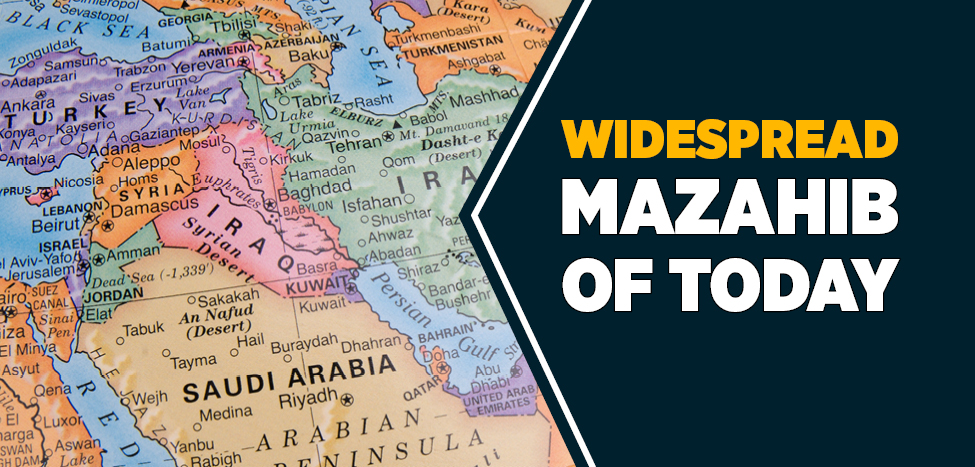What is the common denomination today? 
Mazhab, which means path or way (followed), in context means “the path of fiqh encompassing the ijtihad and understanding of a particular mujtahid.”
During the time of the Prophet, when anybody had a question he would pose it to the Prophet. However, after the death of the Prophet (p.b.u.h), the Sahaba and Tabi’un would solve mat Fetihler sonucu İslam ülkesinin sınırları genişledi. Ebû Hanîfe, İmam Mâlik, İmam Şâfiî, Ahmed b. Hanbel gibi dinin hükümlerini iyi bilen fakihlerin etrafında topluluklar oluşmaya bers by consulting the Sunnah of the Prophet and the Qur’an.
Conquering new lands lead to the expansion of Islamic boundaries. Followers began to collect (group) around scholars such as Abu Hanifa, Imam Malik, Imam Shafi’i and Ahmad b. Hanbal, as all of them were acquainted with deep Islamic knowledge and fiqh. Over time, these groups turned into fiqh schools (mazahib).
The goal of these imams were to enlighten the Muslims; thus they performed ijtihad in the light of the Qur’an and Sunnah, in order to respond to their needs. The imams never claimed to be founders of a particular school of thought, they never obliged people to follow them or spread their message.
The mazahib that have survived with success and still have followers are: The Hanafi, Shafi’i, Hanbali, Maliki and Ja’fari schools. Let’s take a look at these mazahib more closely:
1. The Hanafi school
The imam of the Hanafi school: Abu Hanifa ( 80-150 / 699-767 )
His full name is Nu’man b. Thabit b. Zut’a, however he was addressed as Imam A’zam Abu Hanifa. His origin was from Khorasan, however he was born and raised in Kufa and studied there. He passed away in h.150 in Baghdad. He is the first imam of the Hanafi mazhab. In this school, Abu Yusuf is regarded as the second imam and Imam Muhammad the thir
Abu Yusuf (H.113-182 / M. 731-793)
Abu Yusuf was born in h.113 in Kufa, and died in h.182 in Baghdad. He served as a qadi during the times of three Abbasid caliphs; Mahdi, Hadi and Harun al-rashid. The first person who gained the title “qadi’l qudat” (judge of judges) in Islamic history was Abu Yusuf. His most important book was titled “Kitab-ul kharaj.”
Imam Muhammad (H.132-189/ M.749-804)
His full name was Muhammad b. Hasan ash-shaybani, and he was born in h.132 in the city of Wasit (Iraq). He died in h.189 in Ray (Iran).
The Areas in Which the Hanafi School Became Widespread
The Hanafi school gained dominance in all the lands that were controlled by the Abbasid Empire. The fact that Abu Yusuf was “qadi’l qudat” during this time, lead to the popularity of this mazhab. Today, it is the dominant school in parts of Asia (such as Turkey, Pakistan, India etc.), the Balkans, Caucasia and North Europe etc. It is estimated that 40% of the Muslim population today follow the Hanafi school.
2. The Maliki school
Malik b. Anas ( 93-179 / 712-795 )
Imam Malik was born in Madinah in the hijri year 93. He passed away in 179 in the same city. During his studies, he was the student of Rabi’aturra’y who was a ra’y scholar. He also accumulated knowledge from Abdurrahman b. Hurmuz. Additionally, he took lessons from Nafi’, Ibn Shihab az-Zuhri, Said b. Musayyab, Abu’z-Zinad and Yahya b. Said al-Ansari
The areas in which the Maliki mazhab became widespread
The Maliki mazhab gained popularity mostly in Africa (eg. Tunisia, Algeria, Morocco, Sudan, Egypt) and Andalus. In Hijaz, it is also possible to find a small trace of its followers. The Maliki school was the official mazhab of the Umayyad administration, thus it had an impact on their people. Along with North Africa, it also gained popularity in South Africa and America. It is estimated that 20% of the Muslim world follows the Maliki mazhab.
3. Shafi’i school of thought
Imam ash-Shafi’i ( 150-204 / 767-819 )
His full name was Abu Abdillah Muhammad b. Idris ash-Shafi’i, and he was born in h.150 in a village called Gaza. He died in h.204 in Egypt. He was from the lineage of Quraysh. In Madinah, he met Imam Malik and learned fiqh from him, by also being exposed to Imam Malik’s Muwatta. After some time, he travelled to Yemen and engaged in academic discussions with Omar b. Abi Salama who was the student of al-Awzai.
He went to Baghdad three times and took fiqh lessons from Muhammad b. Hasan ash-Shaybani. After a short while, he returned to Makkah and started to give lessons. He spent the last years of his life in Egypt, and spoke to Yahya b. Hassan who was the student of al-Lays b. Sa’d.
Imam Shafi’i was the first scholar to write about fiqh methodology. His book was called “ar-Risala.” While Imam Shafi’i resided in Baghdad, he wrote a book called al-Hujjah in which he collected his fiqh views. And in Egypt, he compiled Kitab al Umm where he collected his more recent views. He also authored two more books titled “Ahkam-ul Qur’an” and “Ikhtilafu’l hadith.”
The areas in which the Shafi’i school became widespread
The Shafi’i school was especially dominant in Egypt, as Imam Shafi’i spent the last period of his life here.
In the past, Syria was a member of the Awzai school, which no longer has followers today. Those following the Awzai school started to follow the Shafi’i school. The Shafi’i mazhab is the most widespread mazhab in parts of the Middle East such as Syria, Jordan etc. and parts of Asia such as Indonesia, Malaysia etc. It is estimated that 25% of the Muslim world follows the Shafi’i school.
4. Hanbali school of thought
Ahmad b. Hanbal ( 164-241 / 781-855 )
Ahmad b. Hanbal was born in Baghdad in h.164, he was a faqih and scholar of hadith from the ahl-hadith school. He memorized the whole of the Qur’an when he was a child. He studied fiqh from Imam Muhammad and Imam Shafi’i. He did not agree with the arguments that “the Qur’an is created,” thus he was tortured and imprisoned by the administration.
Ahmad b. Hanbal collected about 40,000 ahadith in his book “Musnad.” He also wrote a book called Kitab al-ilal.
Areas in which the Hanbali school became widespread
This mazhab is especially widespread in the Hijaz. Today, most Saudi Arabians follow the Hanbali school. It is estimated that 5% of the Muslim world follows this school.
5. Ja’fari school
Ja’far as-Sadiq ( 80-148 / 699-765 )
The largest branch of Shi’a is the school that encompasses the views of Imam Ja’far as-Sadiq.
He is a respected scholar that has been praised by Sunni sources too. Scholars such as Abu Hanifa, Imam Malik and Sufyan al-Thawri took lessons from him. The Ja’fari school is generally in agreement with other schools. In some of its views it is similar to the Hanafi school, however in other matters, such as faith, it differs from the Sunni schools and has not been considered from ahl us-Sunnah.
Some aspects in which it differs from other schools: Wiping over bare feet during wudu’, prohibition of marriage with Christian or Jewish women, addition of “ash-hadu anna ‘aliyyan waliyyullah” to their adhan, joining duhr and ‘asr prayers and joining maghrib and ‘isha prayers (jam’ taqdeem).
The areas in which the Ja’fari school became widespread
This school became most effective in Iran and countries bordering Iran. Countries that contain a Shi’a (Ja’fari) population are: Iraq, Azarbaijan, Pakistan, Lebanon and Palestine. It is estimated that 10% of the Muslim world today follows the Ja’fari school.
5. The Zaydi school of thought
Zayd b. Ali (Zaydi) (80-122 H./698-740 M.)
Zayd is the son of Zaynal’abidin and grandson of Husayn (r.a). He was a scholar of fiqh from the tabi’un generation. Following provocations, he was martyred in the war with the Umayyad Caliph Hisham b. Abdulmalik.
He was the first person who has written a book about the science of fiqh and he conveyed his knowledge to many scholars. He wrote a book called “Majmu’ ul-kabeer fi’l fiqh.”
Source: Fiqh1 (According To The Maliki School Of Islamic Law), Erkam Publications





